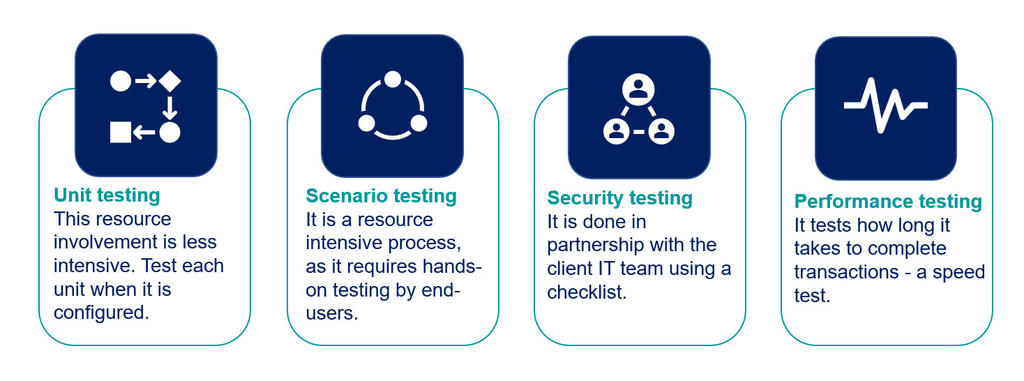
Crucial testing approaches
Testing with Pega Express
The Pega Express™ delivery approach is designed to ensure that your team delivers an application that works. There are multiple kinds of testing to verify that your MLP delivers on the expected business outcomes and works fast enough not to frustrate end users. There are four kinds of testing to determine to use each during the Build phase:
- Unit testing
- Scenario testing
- Security testing
- Performance testing
In the image below, you see what each kind of testing accomplishes.
Unit testing: This resource involvement is less intensive. Test each unit when it is configured.
Scenario testing: It is a resource intensive process, as it requires hands-on testing by end-users.
Security testing: It is done in partnership with the client IT team using a checklist.
Performance testing: It tests how long it takes to complete transactions - a speed test.
Unit testing
A System Architect or developer performs unit testing on their work or a peer's work. It is the least expensive form of testing. Unit testing lets you verify that the application is configured correctly by testing the smallest units of functionality. In a Pega Platform™ application, the smallest unit is an individual rule. The purpose of unit testing is to verify that each element of the application, such as a decision table or a report definition, works as expected.
Unit testing reduces the risk of a configuration error in one rule affecting others and delaying case processing. Use unit testing to find and eliminate configuration errors. By unit testing the individual rules when you configure them, you know that each rule works as expected.
You can avoid common testing mistakes by reviewing documentation on the Pega Express Delivery Resources page, and you can find detailed instructions within the Pega Academy module Unit Testing rules.
Scenario testing
Pega Platform provides user-interface (UI) based scenario testing to confirm that the end-to-end cases work as expected. As part of the Pega Express delivery approach, it is vital to validate that your target end users can use the application features as designed and that the application behaves as expected.
For detailed instructions on how to set up and structure scenario tests, see the Pega Academy topic, Scenario testing.
In the image below, you see how scenario testing works.
Creating scenario tests: Record a set of interactions for a case type or portal in scenario tests. You can run these tests to verify and improve the quality of your application.
Opening a scenario test case: You can view a list of the scenario test cases that have been created for your application and select the one that you want to open.
Updating scenario tests: When the user interface or process flow changes, update the existing scenario test. You can save time and effort by keeping existing tests functional instead of creating new ones.
Group scenario tests into suites: Group related scenario tests into test suites to run multiple scenario test cases in a specified order.
Application - Scenario testing landing page: The scenario testing landing page provides a graphical test creation tool to increase test coverage without writing complex code.
Security testing using a Security Checklist
Security is often set up by user role. Security testing validates that your application allows authorized users to access the system and keeps unauthorized users out. You can test the security configuration of your MLP before release by using the security checklist.
Pega Platform provides a Security Checklist directly in the application, as shown above. In addition, your client’s IT support team might want to verify that the application meets their specific security compliance requirements.
Performance testing
Your team conducts performance testing to verify the speed of the application as perceived by end users. Pega Platform applications provide a full suite of tools to monitor and address performance issues. Your testing team uses these tools during the Build phase to ensure that the application configuration to support your MLP release performs as it should.
You can learn more about the performance tools in the help topic Understanding system resources. Use the performance tools to collect performance statistics. Performance statistics can help you distinguish between performance issues that arise in the Pega Platform server, the database, or external systems called. In all cases, the statistics can help you determine how to improve performance.
You can find downloadable testing documents (such as PDFs that describe how unit testing and performance testing work) on the Pega Express Delivery Resources page.
Check your knowledge with the following interaction.
This Topic is available in the following Module:
If you are having problems with your training, please review the Pega Academy Support FAQs.
Want to help us improve this content?


